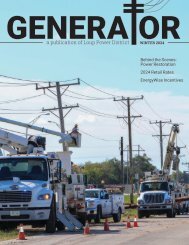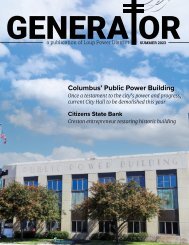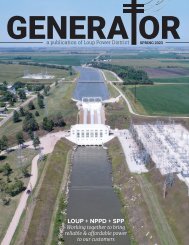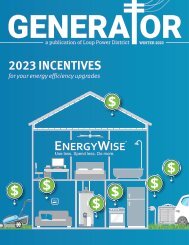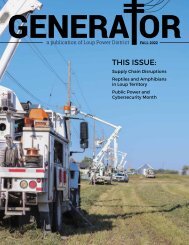Loup Generator — Winter 2022
Learn more about the invasive species in Nebraska and what you can do if you spot them. The 2022 list of financial incentives available to customers who make energy-efficient upgrades. Also in this issue, Mini-Splits 101: an introduction for homeowners.
Learn more about the invasive species in Nebraska and what you can do if you spot them. The 2022 list of financial incentives available to customers who make energy-efficient upgrades. Also in this issue, Mini-Splits 101: an introduction for homeowners.
Create successful ePaper yourself
Turn your PDF publications into a flip-book with our unique Google optimized e-Paper software.
No change to <strong>2022</strong> retail rates<br />
Retail rates for <strong>Loup</strong> Power District’s<br />
retail customers will remain the same in<br />
<strong>2022</strong> for the fifth consecutive year.<br />
The <strong>Loup</strong> Power District Board of Directors<br />
reviewed current rate levels as well<br />
as budgeted revenue and expenses at<br />
the November and December board<br />
meetings. This also included a review of<br />
a retail cost of service study performed<br />
by management.<br />
As part of this review, the board<br />
analyzed the purchased power costs<br />
from Nebraska Public Power District<br />
(NPPD), the District’s wholesale power<br />
supplier.<br />
NPPD’s overall costs to <strong>Loup</strong> are not<br />
expected to change for <strong>2022</strong>, even<br />
though some wholesale rates did<br />
change between the summer and winter<br />
season. Therefore, the District’s Board<br />
of Directors felt there was no need to<br />
change retail rates at this time.<br />
“Prior to the recent run of consistent<br />
retail rates, the District has reacted<br />
to changes in wholesale power and<br />
operational costs by making changes<br />
to the retail rates,” said Jim Donoghue,<br />
chairman of <strong>Loup</strong>’s Rates Committee.<br />
“However, the District Board has<br />
worked with management to keep retail<br />
rate levels steady, even given the effects<br />
of the damages from the 2019 storm to<br />
the District’s hydroelectric system and<br />
the impact of the COVID-19 pandemic<br />
on District customers in 2020 and 2021.”<br />
Donoghue added that <strong>Loup</strong>’s board<br />
has implemented a long-term strategy<br />
to maintain its reserve margin at<br />
reasonable levels and keep retail rates<br />
competitive.<br />
<strong>Loup</strong> Power District’s overall rates are<br />
24.8 percent below the national average<br />
and 8.1 percent below the Nebraska<br />
average based on data from a 2020<br />
American Public Power Association<br />
survey.<br />
“<strong>Loup</strong>’s rates remain among the lowest<br />
in Nebraska and the nation,” said <strong>Loup</strong><br />
Board Chairman Ross Knott.<br />
Average Prices for Residential Electricity<br />
2020 figures, in cents per kWh<br />
CA<br />
20.5¢<br />
WA<br />
9.9¢<br />
OR<br />
11.2¢<br />
NV<br />
11.3¢<br />
AK<br />
22.6¢<br />
ID<br />
10¢<br />
UT<br />
10.4¢<br />
AZ<br />
12.3¢<br />
MT<br />
11.2¢<br />
WY<br />
11.1¢<br />
CO<br />
12.4¢<br />
NM<br />
12.9¢<br />
HI<br />
30.3¢<br />
Overall, <strong>Loup</strong> Power District’s rates are<br />
in the lowest tenth percentile both statewide<br />
and nationally.<br />
Energy or kilowatt-hour (kWh) usage<br />
is always the determining factor in a<br />
customer’s bill.<br />
Customers in all rate classifications<br />
continue to have opportunities to<br />
reduce their costs by taking advantage<br />
of numerous programs offered by the<br />
District.<br />
These programs include energy incentives<br />
and home energy audits. For more<br />
information on rates and the Energy-<br />
Wise program, visit loup.com.<br />
ND<br />
10.4¢<br />
SD<br />
11.8¢<br />
NE<br />
10.8¢<br />
KS<br />
12.9¢<br />
TX<br />
11.7¢<br />
OK<br />
10.1¢<br />
MN<br />
13.2¢<br />
IA<br />
12.5¢<br />
MO<br />
11.2¢<br />
AR<br />
10.4¢<br />
WI<br />
14.3¢<br />
LA<br />
9.7¢<br />
IL<br />
13¢<br />
MS<br />
11.2¢<br />
U.S. Average: 13.2¢ per kWh<br />
MI<br />
16.3¢<br />
IN OH<br />
12.8¢ 12.3¢<br />
KY<br />
10.9¢<br />
TN<br />
10.8¢<br />
AL<br />
12.6¢<br />
VT: 19.5¢<br />
NH: 19¢<br />
MA: 22¢<br />
RI: 22¢<br />
CT: 22.7¢<br />
WV<br />
11.8¢<br />
Under 10 ¢<br />
10¢ to 12.5¢<br />
PA<br />
13.6¢<br />
12.8¢<br />
GA<br />
12¢<br />
FL<br />
11.3¢<br />
NY<br />
18.4¢<br />
VA<br />
12¢<br />
NC<br />
11.4¢<br />
SC<br />
Residential Average Price<br />
(cents per kilowatt-hour)<br />
Over 12.5¢<br />
Source: U.S. Energy Information Administration<br />
Numbers rounded to nearest tenth of a cent<br />
<strong>Loup</strong>’s retail rates<br />
are 24.8% below<br />
the national average<br />
and 8.1% below<br />
Nebraska’s average.<br />
ME<br />
16.8¢<br />
NJ: 16¢<br />
DE: 12.6¢<br />
MD: 13¢<br />
DC: 12.6¢<br />
For more information on the District’s retail rates and energy-saving programs,<br />
visit the District’s website at www.loup.com.<br />
12 | GENERATOR





